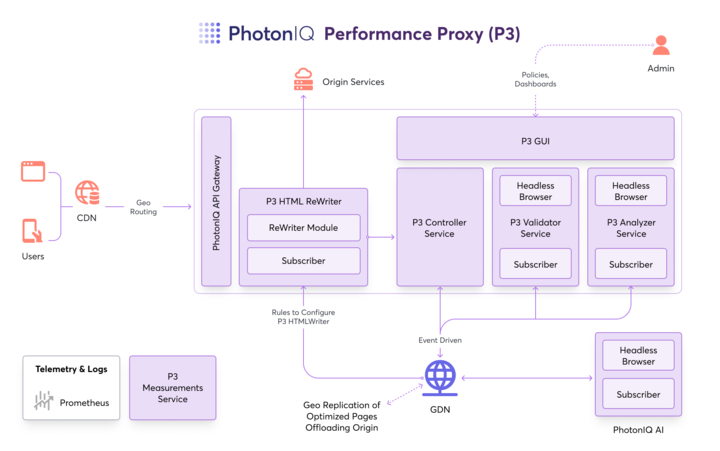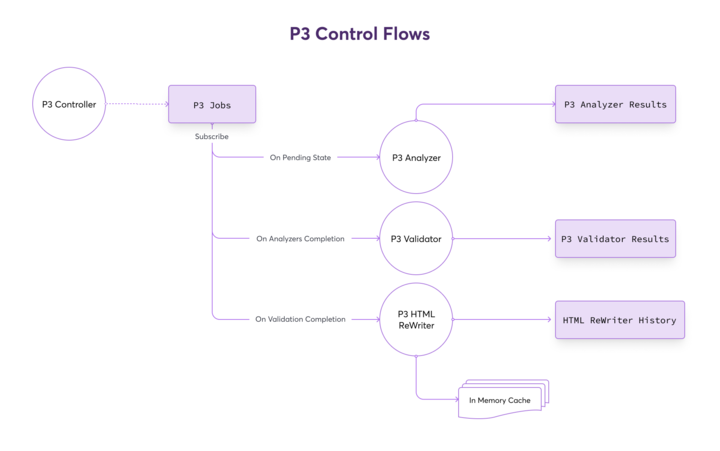How P3 works
PhotonIQ Performance Proxy (P3) revolutionizes web performance optimization by capturing and enhancing web requests through a sophisticated, server-side processing environment at the network edge. This innovative approach enables dynamic web content optimization, ensuring faster page loads and improved user experience across different devices and networks.
This overview provides insight into the operational workflow of P3 and the technologies that make it an effective tool for modern web optimization.
P3 Architecture Overview
The PhotonIQ Performance Proxy (P3) architecture is designed to optimize website performance by dynamically applying predefined optimization rules to web requests.

Here’s a high-level breakdown of how the P3 system processes a request:
Initial Request Handling:
- A user accesses a URL through a desktop or mobile browser, sending a request to the Content Delivery Network (CDN).
- The CDN, configured with specific URLs for P3 optimization, redirects eligible requests to P3.
Request Routing to P3:
- Requests are first received by the PhotonIQ API Gateway.
- The API Gateway forwards the request to P3.
Optimization Process: P3 has three components that process user requests:
- The first component is the HTML ReWriter, which checks for applicable optimization rules stored in its memory cache based on the URL pattern.
- Requests that match the available rules are immediately optimized, and the optimized response is sent to the user.
Handling Missing Optimizations:
- If the HTML ReWriter lacks the rules for a request, it sends a query to the Controller.
- The Controller checks configured policies to see if the URL matches any existing patterns.
- If there are no matching policies, P3 processes the request without P3 optimizations and passes through as is from the origin.
- If the HTML ReWriter lacks the rules for a request, it sends a query to the Controller.
Job and Policy Handling:
- If a matching policy exists but no current job covers the request, the Controller initiates a new job.
- This job is handled by the Analyzer and Validator to ensure the new rules are effective and do not break page functionality or aesthetics.
Optimization Rule Validation:
- The Analyzer uses machine learning to assess the page against the configured optimizers and formulates a set of rules.
- The Validator then checks these rules using computer vision techniques to ensure they do not visually or functionally disrupt the page. It tests across various device resolutions to ensure broad compatibility.
Finalizing Optimizations:
- Once validated, the optimization rules are stored in a collection accessed by the HTML ReWriter.
- The HTML ReWriter then applies these rules to incoming requests matching the criteria, optimizing them before delivery to the end user.
P3 Control Flows Diagram
The control flow diagram illustrates the detailed interactions within the P3 architecture.

- The process begins when a request reaches the Controller, which determines the necessity for creating a job based on the incoming URL and associated policies.
- Components subscribe to updates from this job, processing the request as outlined:
- Analyzer: Takes the job and policy details, including policy ID and URL pattern, and determines safe optimizations.
- Validator: Runs validations against the Analyzer’s suggestions on the specified device types and optimization levels.
- HTML ReWriter: Updates its cache with new rules post-validation and applies them to future matching requests.